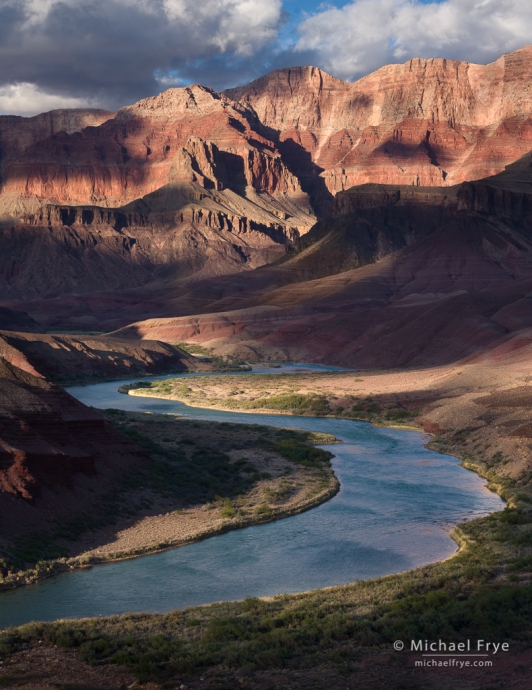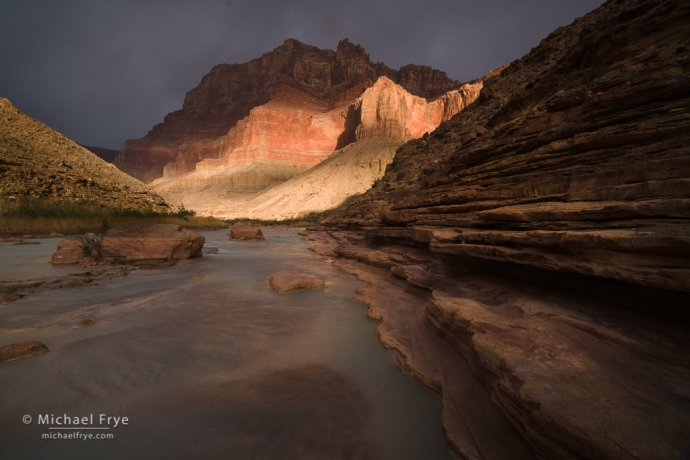
Dappled light along the Colorado River, Grand Canyon National Park. Watching the cloud shadows move across the canyon from this spot was one of the highlights of the trip for me.
Most people make their best photographs of places or subjects they’re familiar with.
In landscape photography, it helps immensely if you know an area well, and know what spots might work best under certain conditions, so you can put yourself in the right place at the right time.
I think it’s also natural and inevitable that we’re going to make our best and most meaningful images when we feel a connection with the subject or place. You can often trace a direct correlation between the depth of that connection and the depth of the imagery. And making those connections takes time.
I thought about those questions a lot prior to and during our recent raft trip down the Grand Canyon. It was my second time making this trip, so I had some familiarity with the inner canyon. For my co-instructor, Jerry Dodrill, it was his ninth trip down the canyon, so we all leaned heavily on his experience to get us to great locations at the right times, which was immensely helpful.
And of course our river guides had done this before. For our lead guide, Ed, it was his 284th trip down the Grand Canyon. Wow!
But while one of our participants had been down the canyon before, for everyone else it was their first time. One person had never even camped before! (He loved it, by the way.) Aside from the photographic challenge of capturing an unfamiliar location, we all had to adapt to river life. Our guides made great meals for us, so that part was easy and wonderful. But the rest of it – sleeping on the sand under the stars (we had tents, but rarely used them), packing all our stuff into dry bags in the morning, loading it all onto the boat, then unloading and unpacking at the next camp, bathing in the river, using the “groover” – all took some getting used to.
Given all that newness, Jerry and I encouraged everyone to be open to absorbing the experience and whatever it brought. Let the river and canyon speak to you, develop your own connection to the place over the ten days we were down there, and let that experience and connection come through in your photographs.
For me, even though this was only second time rafting down the river, I already felt a deep connection with the canyon. My first trip in 2003 was a profound, moving, even life-changing event. Going down the canyon again brought all those feelings back, but also created new experiences and impressions.
Traveling down the river is visual feast. Every bend brings new views: towers and spires, cliffs cascading into the river, light bouncing off the walls, reflections in the water, fern-filled grottos, bighorns grazing by the shore, swallows twisting overhead, patterns in the rocks, intriguing side canyons – and on an on.
It’s almost overwhelming, especially since it’s all so vast. Everyone knows the Grand Canyon is big. It’s 5,000 to 6,000 feet deep at its deepest point, and 12 miles wide. It’s also quite long: we ran 225 river miles from our put-in point at Lee’s Ferry to our takeout point at Diamond Creek, and that didn’t include the lowest stretch of the canyon that’s partially flooded by Lake Mead (though that water has receded during our recent long drought).
But it’s one thing to know those statistics, and quite another to experience that immensity first-hand, from deep inside it. Even floating through the canyon from one end to the other at river level, we only glimpsed a small portion of it. Often our view was limited to the narrow inner gorge, or one or two layers beyond that. Even those expanses seemed huge. But then occasionally we would catch glimpses of the north or south rim, lined with pine trees, floating far, far above us, miles and miles away, giving us a sense of all the layers and terraces and the vast territory between river and rim.
But for all that immensity, rafting the Colorado River in Grand Canyon is also an intimate experience. You’re down in the depths, at the very bottom of the canyon, getting splashed by the river’s rapids, bathing in it, laying on its sandy beaches at night with the sound of the river lulling you to sleep, clambering over rocks along the shore, swimming in a pool beneath a waterfall… You’re not just looking at the canyon, you’re living in it.
In my photographs I wanted to convey both the grandeur and the intimate beauty. I knew it would be especially challenging to make images that captured even a tiny bit of the majesty and immensity of the canyon, but I looked for opportunities when I could, and luckily we got some interesting clouds and weather that helped add drama to some big landscape views.
On one memorable afternoon we climbed a hillside above the river in a more open part of the canyon. We had seen beautiful clouds all day, but when we reached the top of the hill the clouds seemed to be dissipating. After a while, however, more clouds moved in, and we were treated to some wonderful dappled light as cloud shadows moved across the canyon (see the photograph at the top of this post). I couldn’t have asked for better light for that spot.
I’ve included a few more “big” landscape views here, but as I said, that’s only part of the story for me, so I’ll show some more intimate views in future posts.
— Michael Frye
P.S. It looks like I’ll be doing this trip with Jerry again in 2024! Dates haven’t been set yet, but if you’re interested please contact Justin Black at Visionary Wild and let him know you want to be on the waiting list.

Sunset along the Colorado River, Grand Canyon National Park. This was our first evening on the river, with some beautiful clouds and pink light.

Sun setting on cliffs above a rapid in the Colorado River, Grand Canyon National Park. You can’t actually see the rim of the canyon in this view. The high cliffs catching the sunset light are Redwall Limestone, at least a thousand feet below the North Rim.
Related Posts: Through the Grand Canyon; Down the River; Canyon Mood
Michael Frye is a professional photographer specializing in landscapes and nature. He is the author or principal photographer of The Photographer’s Guide to Yosemite, Yosemite Meditations, Yosemite Meditations for Women, Yosemite Meditations for Adventurers, and Digital Landscape Photography: In the Footsteps of Ansel Adams and the Great Masters. He has also written three eBooks: Light & Land: Landscapes in the Digital Darkroom, Exposure for Outdoor Photography, and Landscapes in Lightroom: The Essential Step-by-Step Guide. Michael has written numerous magazine articles on the art and technique of photography, and his images have been published in over thirty countries around the world. Michael has lived either in or near Yosemite National Park since 1983, currently residing just outside the park in Mariposa, California.










I love how the river’s twists and turns echo right up the canyon wall in the top photo, Michael. It sounds like an amazing trip!
Thanks Vivienne! It was an amazing trip – I highly recommend it if you have a chance to go.
Amazing images. Just got back from a 7-day trip on the river last month. Also setting off from Lee’s Ferry. His descriptions were spot-on. On our trip, recovered a bag of photographic equipment left behind by another group going down the river on a photographic journey.
So glad you got to make that trip Rita! I don’t think anyone on our trip left behind a bag of photo gear. Where did you find it?
Hi Michael
Love those shadows above the curves of the river. Seeing the canyon in a new ‘light’!
All the best, David
Thanks very much David!